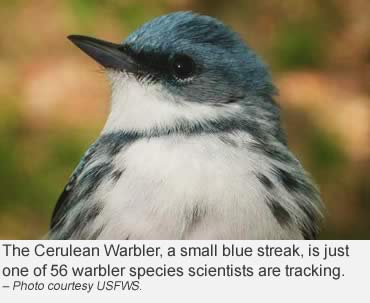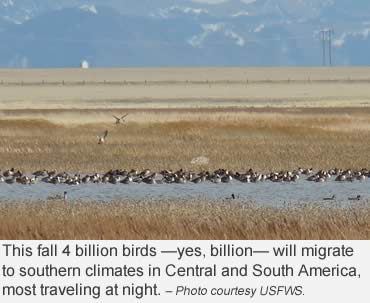Photo: Cerulean Warbler outfitted with light-level geolocator unit. Photo by Lesley Bulluck, courtesy Virginia Department of Game and Inland Fisheries
Blue streaks—visual images akin to electric spears of lightning, quick flashes of brilliant blue against an early fall sky—are puzzles that disappear as quickly as they arrive.
One those tiny streaks could well be a Cerulean Warbler, a nifty little bird whose vocalizations sound a little buzzy. While you’re looking around trying to locate it, it’ll stay hidden in the highest canopy of the forest’s trees.
This member of the warbler family has been getting a lot of special attention this fall before it leaves its summer home in the East, the Midwest or Southeast to fly 2,500 miles to Central and South America on its migratory trip to warmer climates.
 Researchers working across ten states are beginning an important study, by first determining where—exactly where—the Cerulean Warblers’ wintering grounds are.
Researchers working across ten states are beginning an important study, by first determining where—exactly where—the Cerulean Warblers’ wintering grounds are.
That’s because its numbers have been declining dramatically, although it is not listed as an endangered species. It’s a puzzle that needs an answer so scientists can understand what to do next.
The project begins with a simple idea. First, catch the bird. Next, very, very carefully outfit them with a light-level geolocator unit. Those are the first, important steps. Then, months later, when the birds return from their tropical winter homes, it’ll be time to catch them again.
The geolocators do not transmit data during the birds’ flights; instead it needs to be removed from the bird so its data can be downloaded and studied.
The research team cooperating in the project has representatives from Virginia’s Department of Game and Inland Fisheries, Virginia Commonwealth University, The Nature Conservancy and the Virginia Society of Ornithology.
Researchers rely on technology to assist their studies, and supporting groups fund the purchase of geolocators.
In Virginia during the spring of 2017, 13 geolocators were deployed on captured Cerulean Warblers and another 14 Cerulean Warblers were color banded.
By May and June of 2018, the efforts to recapture the birds returning from their wintering grounds had begun, and only one bird bearing a geolocator was found. The bird that transported it was successfully captured in its same territory from the previous season.
Other states involved in the study reported similarly low numbers of recaptured birds, however, that single geolocator unit retrieved in Virginia was full of valuable information.
Another project similar to the Cerulean Warbler project involves the Golden-winged Warbler, also a long-distance traveler, and data collected from it has provided some important insight into the causes of its decline.
Warblers are popular among bird-watchers of all ages. They are small perching birds, but they are often difficult to identify because their feathers change colors seasonally, and their songs and calls may not easily distinguish one from another. There are 56 warbler species in America and Canada. —Resource, Virginia Department of Game and Inland Fisheries
 Radar computes fall migration number at 4 Billion birds
Radar computes fall migration number at 4 Billion birds
Using cloud computing and data from 143 weather radar stations across the continental United States, Cornell Lab of Ornithology researchers can now estimate how many birds migrate through the U.S. and the toll that winter and these nocturnal journeys take. Their findings are published in Nature Ecology & Evolution.
"We've discovered that each autumn, an average of 4 billion birds move south from Canada into the U.S. At the same time, another 4.7 billion birds leave the U.S. over the southern border, heading to the tropics," notes lead author Adriaan Dokter, an Edward W. Rose postdoctoral fellow at the Cornell Lab.
"In the spring, 3.5 billion birds cross back into the U.S. from points south, and 2.6 billion birds return to Canada across the northern U.S. border."
In other words, fewer birds return to their breeding grounds after going through fall migration and spending months on their wintering grounds.
But the researchers were surprised to find that the migrants arriving across the U.S. southern border had an average return rate of 76 percent during the 5 years of the study (2013 to 2017) and the birds wintering in the U.S. had only an average return rate of 64 percent.
"Contrary to popular thought, birds wintering in the tropics survive the winter better than birds wintering in the U.S.," says Andrew Farnsworth, co-author of the study and leader of the Cornell Lab's aeroecology program.
"That's despite the fact that tropical wintering birds migrate three to four times farther than the birds staying in the U.S."
—Cornell University, Cornell Lab of Ornithology